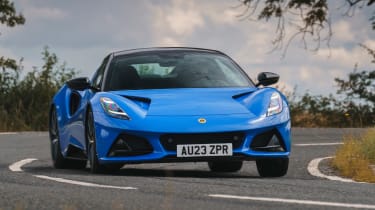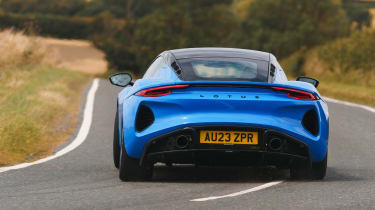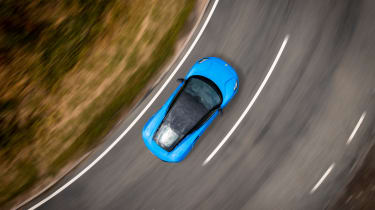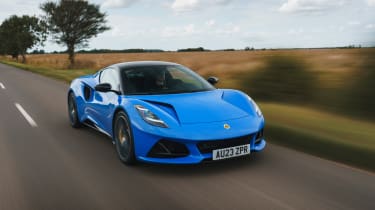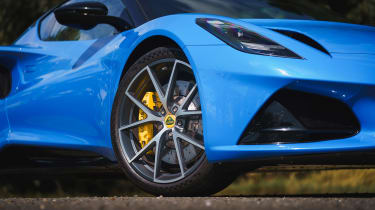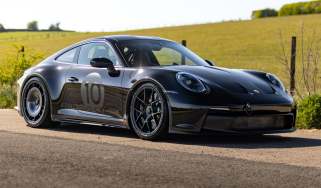Lotus Emira i4 2023 review – the final combustion-engined Lotus
The AMG-engined Emira i4 is the last new internal combustion engined Lotus sports car, and it's one of the best
It’s fair to say the Emira didn’t have the smoothest of launches. And I don’t mean the soaking that managing director Matt Windle got when the heavens opened over Hethel as he introduced Lotus’s first ‘all new’ sports car since the Elise. Our first drive in the summer of 2022 yielded mixed results, and the same was the case for other magazines.
A mismatched specification for the pre-production test car presented us with a V6-engined, six-speed-manual First Edition with a Sport-spec chassis – stiffer springs and dampers – but equipped with the more road-biased Goodyear Eagle F1 tyres from the Tour-spec car in place of the Michelin Pilot Sport Cup 2s that Sport models leave the factory with. It made for a strong on-road car, albeit one that reached the limit of its tyres quite quickly when pushed on the road and even quicker when driven on track.
A solid four stars was the result, with a strong desire to drive a finished production car as soon as possible, hopefully in time for eCoty 2022. Which didn’t happen due to Lotus experiencing supply-chain issues, which pushed back customer deliveries and therefore the availability of a test car. We’ve still not been able to get behind the wheel of a production-spec Emira V6. Few have. However, this is a production-specification, four-cylinder Emira, or i4 in Lotus-speak. It’s powered by a Mercedes-AMG 2-litre, four-cylinder turbocharged engine that’s hooked up to an eight- speed dual-clutch gearbox, just as it is in the AMG A45 S hyperhatch.
More reviews
Why Mercedes for the powertrain? Using the most powerful production four-cylinder in the world is quite a USP, although rather than the A45 S’s full-fat 415bhp and 208bhp per litre, the Emira produces 360bhp and has to make do with 180bhp per litre. Although it doesn’t take a genius to work out how this leaves plenty of headroom for future four-cylinder derivatives with more power and torque. Another rationale for the engine choice is that the CEO of Geely, which owns Lotus, is also a rather significant shareholder in Daimler.
It’s not a great-sounding engine, with a coarse undertone that’s ever-present and doesn’t build to anything remotely close to a tune. There’s a lot of air-intake noise immediately behind the passenger cell, both externally and in the engine bay against the bulkhead, that adds to the decibels. The note doesn’t sound as light and as unobtrusive as that of the Alpine A110’s turbocharged 1.8-litre four, but neither does it grate like Porsche’s four-cylinder boxer motor in the Cayman. Switch to Sport or Track mode and the exhaust flaps open, drowning out much of the engine’s vocals. What it lacks in aural accompaniment it more than makes up for with the performance it delivers.
At a claimed 1446kg – 40kg lighter than the V6 we weighed on our scales – the Emira four-cylinder is no featherweight Elise, but its 253bhp per ton provides it with lightning reflexes off the line and a punch that continues to hit as you climb through the gears. Thankfully the gearbox’s mapping isn’t predisposed to reach eighth as quickly as possible; instead it allows the engine to breathe through its power delivery rather than heaving along on its chunky 317lb ft of torque. With power peaking at 6600rpm it is happy to rev, although if you’ve switched to using the paddles your trigger finger needs to be on its A-game to avoid a strong rebuttal from the engine’s limiter.
Speaking of paddles, they’re actually switches and are rather disappointing as a consequence. And the steering-wheel spokes, which the paddles are attached to the back of, are set lower than you would perhaps expect on the rim, requiring an unusually large stretch of your digit to change gear. Longer paddles with a nicer action would resolve it in a click of your fingers. And while we’re on the interior, the seat still isn’t right. It’s comfortable with plenty of adjustment but it doesn’t hold you across the shoulders strongly enough and you sometimes find yourself bracing your hips against the bolsters in quicker, tighter turns.
Back to the oily bits. Lotus didn’t simply take the AMG powertrain and straight swap it for the V6. For a start it sits on a 12kg-lighter aluminium rear subframe compared to the Toyota engine, and from the B-pillar back much of what lies beneath Russell Carr’s exterior penwork is bespoke to the i4, including the electronic control systems, suspension uprights and aluminium wishbones, the wheels and the sheer panels. Despite the loss of two cylinders, packaging for the four-cylinder motor remains as tight as it does for the Toyota V6 when you lift the plastic engine cover.
‘We worked with Mercedes and Bosch extensively on the software,’ says Gavan Kershaw, Lotus’s director of attributes and product integrity. ‘We were able to ask [AMG] for the exact throttle progression and gearshift mapping we wanted and that we knew would suit the car in all the drive modes to deliver the consistency we wanted.’This work was the most extensive of its kind that Lotus has carried out. Both the V6 and i4 models were developed alongside each other, but the first Mercedes engines didn’t arrive at Hethel until some time after the programme had started, which would normally cause delays and introduce costs, two factors Lotus wasn’t keen on, or indeed able to entertain.
‘Because we knew the weight of the four-cylinder powertrain, the power and torque characteristics, the weight distribution, etc, etc, we were able to ballast V6 test cars to be i4s and start work on its electronics while we waited,’ explains Kershaw. ‘Working directly with Bosch we were able to develop the two ECUs required (the engines use different units) to run identical electronics and then we adjusted these accordingly between the six- and four-cylinder cars in terms of torque management and the e-diff for the i4.’
One of the biggest adjustments was to incorporate Lotus’s electro-hydraulic power- steering system on the i4 (the steering column, front suspension and brakes are the same as on the V6) to replace the Mercedes EPAS system that runs off the engine. Then there was the software required for the traction and stability control systems and the aforementioned new e-diff.
On the road the Emira i4 feels planted, hunched on its Sport springs and dampers (around six to seven per cent stiffer than the Tour items, but with up to 40 per cent greater operating range). It’s stiffer than you would expect from a Lotus, with firm movements through the body, and on poor UK roads it’s immediately noticeable and attention-grabbing, if not as sharp-edged as a Cayman GT4.
Had I only driven the car for a day on the road I would be imploring every potential customer to avoid the Sport chassis at all costs. Yet with time and miles you begin to tune into its characteristics, know when to react to the steering wriggling in your hands and when to take a tighter grip. You also build the knowledge that those firmer movements through the springs and dampers at lower speeds settle as your pace increases, delivering a calmness and control as your confidence builds and the chassis begins to work to its full potential.
And it’s some potential. The combination of a quick turn-in, some genuine feel (thank you Lotus) back through the steering and grip from those Cup 2s has the Emira’s nose locked in with a single input from your wrists, then it’s up to you to manage the throttle and drive out of the corner on the torque and power wave to be red along the tarmac. It’s a clean, singular motion from the moment you apply the first degree of lock to when you straighten the wheel again. Pure and precise.
Where at lower speeds there feels a reluctance and little desire to play, at medium pace the rewards begin to materialise as you learn to ask more of those sticky Michelins, receive more detail back to your fingertips via the Alcantara patches on the steering wheel, and begin to squeeze the throttle harder and earlier. Before you know it the e-diff has already rolled up its sleeves and is stuck in, braking each rear wheel independently and accordingly to manage your line and distribute the performance you’ve asked for.
It feels intuitive at all times, with no clumsy snatches of brake here or a dump of torque there to nanny and interfere, simply a flow of wizardry to assist where needed. On track the i4 Emira’s capabilities burst through to the surface. Drive like a Golf R owner in a TikTok video and the electronics will go above and beyond to prevent you from going viral. Greasy hairpin, third gear, full lock and full throttle and you barely feel the system kick in, despite the car still travelling in the direction you want it to go.
Up the ante and turn in a little quickly through a damp fourth-gear kink and you will have already reacted to the messages streaming back at you as all four Cup 2s begin to slide across the surface, applying a little more right foot along with an equally small amount of corrective lock to straighten up on the exit as the diff loads and unloads to maintain the balance and guide you on your way. There’s a natural intuition to the way the Emira gets in, through and out of a corner. As the driver you’re always dictating the process, the car responding to your commands, but when required there’s a safety net on hand to nudge you in the right direction. How big a nudge you need is all down to you.
With more track time you build more confidence, winding the systems back as you nudge the drive modes up to Track, and immediately you begin to appreciate that the i4 is as precise and inspiring as every Lotus that has gone before it. It’s not a car for showboating, but it allows even the most ham-fisted to hold a slide and enjoy that sensation of a car moving beneath them, feeling the limits and looking over the edge without scaring yourself into a spin. It feels less edgy at the limit than an A110, more planted and sure of itself, although it lacks the on-road pliancy the French fancy has in abundance. It also lacks that ultimate all-round polish of a Cayman, but then again, few cars can match the Porsche for this.
The Emira is not an Elise, Exige or Evora. Its DNA (and extruded aluminium construction) are shared but the new car’s objectives are very different, as this first drive highlights. Some will think it’s not Lotus enough, others will be blown away by the duality, quality and usability the Emira offers that no Lotus has done in the last 70 years. Yes, there are small areas of improvement required and potential customers should try both Tour and Sport chassis options before buying, but the four-cylinder Emira is an inspiring last petrol-powered Lotus and a great sports car.
Price and Rivals
At the car’s launch Lotus spoke of a sub-£60,000 Emira but we’re still some way from that and the i4 First Edition model starts at £81,495 – we’re not sure how they can chip £20,000 from the price to reach that promised entry price.
It makes the £62,490 A110 S look the bargain it is. It might only produce 296bhp but it weighs around 300kg less than the Emira, too, and so well sorted are the Alpine’s dynamics that you’d swear blind it too had been developed in Hethel.
It’s a similar story with Porsche’s Cayman S, which starts at £63,999 for a PDK equipped model. Its four-cylinder turbocharged engine produces a similar 345bhp and at 1385kg the PDK version weighs 61kg less than the Lotus; although its engine sounds awful. Truly awful. And then there’s the uncomfortable issue of a PDK-equipped six-cylinder Cayman 4.0 GTS costing £77,656, which highlights the Emira’s biggest issue: it might look and feel like a genuine supercar, but it’s priced accordingly.

